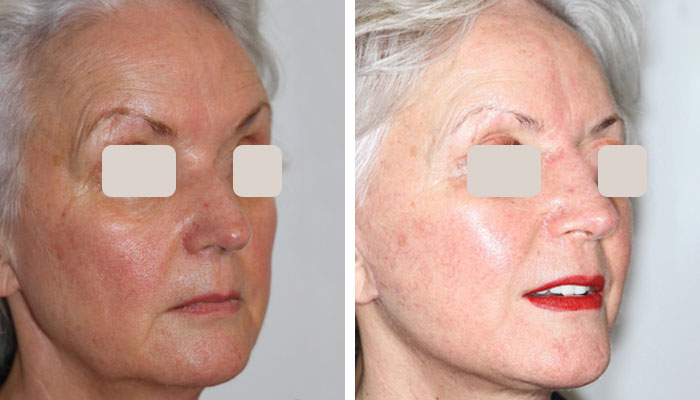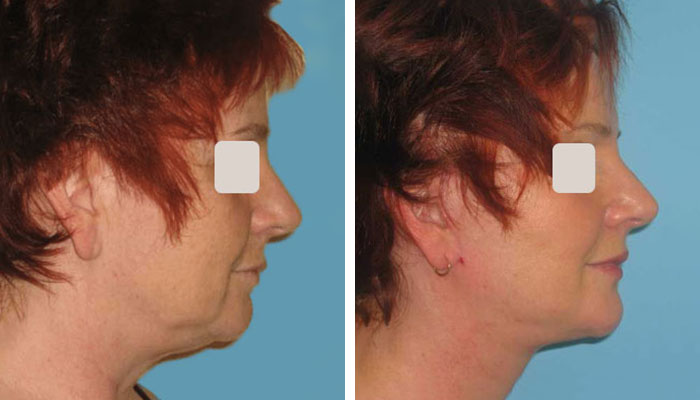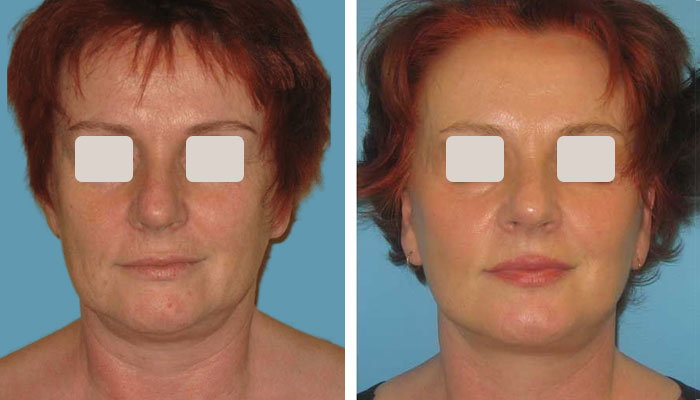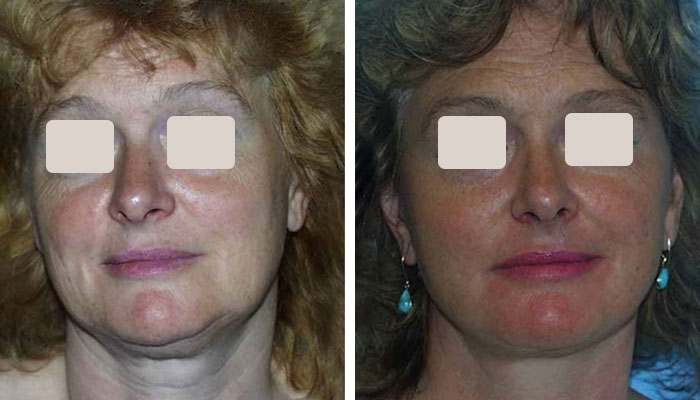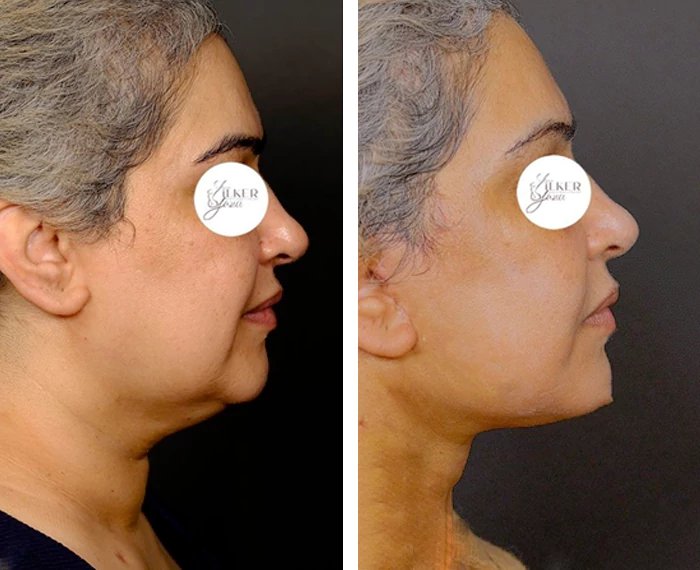What is a neck lift?
A neck lift, also known by other technical names including ‘lower rhytidectomy’, ‘platysmaplasty’, or ‘cervicoplasty, is a cosmetic surgical procedure that aims to improve the appearance of the neck and jawline. It is typically performed to address signs of aging such as sagging skin, excess fat deposits, and muscle laxity in the neck area.
During a neck lift, a plastic surgeon will make incisions either under the chin or behind the ears, or both, depending on the specific case. Through these incisions, excess skin is removed, and underlying muscles may be tightened or repositioned. In some cases, liposuction may be used to remove excess fat. The remaining skin is then re-draped and sutured, resulting in a smoother, more youthful neck contour.
Neck lift procedures can be tailored to each individual's needs and may be performed alone or in conjunction with other facial rejuvenation procedures, such as a facelift or eyelid surgery. The goal is to achieve a balanced and natural-looking result while enhancing the overall appearance and profile of the neck.
What is the purpose of a neck lift?
People choose to undergo a neck lift for various reasons related to aesthetic concerns and signs of aging in the neck area. Some common reasons include:
- Sagging skin: As individuals age, the skin in the neck area may lose elasticity and begin to sag, resulting in the appearance of jowls or a "turkey neck." A neck lift can help tighten and remove excess skin, resulting in a more youthful and defined neck contour.
- Muscle laxity: The platysma muscles in the neck can weaken and separate over time, leading to the development of vertical bands or a "necklace" appearance. A neck lift can address muscle laxity by tightening, repositioning, or removing a portion of the platysma muscles.
- Excess fat deposits: Fat deposits can accumulate under the chin or along the jawline, creating the appearance of a double chin or fullness in the neck area. Liposuction or direct fat removal during a neck lift can help reduce these fat deposits and improve neck contour.
- Loss of jawline definition: Aging and genetics can cause a loss of definition in the jawline, leading to a less defined or "weak" jawline appearance. A neck lift can help restore a sharper, more youthful jawline contour by addressing sagging skin, muscle laxity, and excess fat.
- Personal confidence and self-esteem: Many individuals choose to undergo a neck lift to enhance their overall appearance and boost their self-confidence. A rejuvenated neck and jawline can contribute to a more youthful and harmonious facial profile.
It is essential for individuals considering a neck lift to have realistic expectations and consult with a qualified plastic surgeon who can assess their specific concerns and determine the most appropriate treatment plan.
Should I get a neck lift or a facelift?
The decision to undergo a neck lift or a facelift depends on your specific concerns and goals. While both procedures can address signs of aging in the face and neck, they target different areas and have distinct outcomes. Here are some factors to consider:
Neck lift:
- Focuses primarily on rejuvenating the neck and jawline.
- Addresses concerns such as sagging skin, muscle laxity, excess fat, and vertical bands in the neck.
- Ideal for individuals with significant aging or loose skin in the neck area while maintaining relatively good skin elasticity in the face.
Facelift:
- Targets the lower face, cheeks, and jowls.
- Addresses concerns such as deep facial wrinkles, sagging skin, and loss of facial volume.
- Suitable for individuals with aging signs in the lower face and midface, including the cheeks and nasolabial folds.
In some cases, a combination of both procedures may be recommended to achieve comprehensive facial rejuvenation. It is crucial to consult with a board-certified plastic surgeon who can evaluate your specific needs, conduct a thorough examination, and provide personalized recommendations.
Who are ideal candidates for a neck lift?
Ideal candidates for a lower rhytidectomy are individuals who have specific concerns and characteristics that can be effectively addressed through the procedure. While a consultation with a qualified plastic surgeon is necessary to determine individual candidacy, here are some general factors that may make someone a suitable candidate for a neck lift:
- Visible signs of aging in the neck area: Candidates for a neck lift typically have noticeable signs of aging in the neck, such as sagging skin, excess fat deposits, muscle laxity, or the presence of neck bands. These concerns may be causing self-consciousness or dissatisfaction with their appearance.
- Good overall health: Candidates should be in generally good health and able to undergo surgery. They should not have any underlying medical conditions that could pose a risk during the procedure or the recovery phase.
- Realistic expectations: It is important for candidates to have realistic expectations about the outcomes of a neck lift. While the procedure can provide significant improvements, it cannot stop the natural aging process entirely or completely change one's appearance.
- Non-smokers: Smoking can impair the healing process and increase the risk of complications. Ideal candidates for a neck lift are non-smokers or willing to quit smoking for a certain period before and after the surgery.
- Stable weight: Candidates should have a stable weight as significant weight fluctuations can affect the results of the procedure. It is generally recommended to reach a stable weight before considering a neck lift.
- Psychological readiness: Candidates should be emotionally and mentally prepared for the procedure, understanding the potential risks, the recovery process, and the commitment required for optimal results.
It is important to consult with a qualified plastic surgeon who can assess your individual circumstances, evaluate your aesthetic goals, and determine if a neck lift is the most appropriate procedure for you. They will conduct a thorough evaluation and provide personalized recommendations based on your specific needs.
How is a neck lift performed?
A neck lift is a surgical procedure that involves several steps to address specific concerns in the neck and jawline area. The exact techniques used may vary depending on the individual's needs and the surgeon's approach. Here is a general overview of how a neck lift is typically performed:
- Anesthesia: The procedure is usually performed under general anesthesia or local anesthesia with sedation to ensure the patient's comfort throughout the surgery.
- Incisions: The surgeon will make incisions in strategic locations, typically hidden either under the chin behind the ears, or both. The choice of incision pattern depends on the specific goals of the surgery and the patient's anatomy.
- Neck muscle tightening: The underlying neck muscles (platysma muscles) may be tightened or repositioned during the procedure. This can involve suturing the muscles together to create a firmer foundation and improve the neck contour.
- Liposuction: If there are excess fat deposits in the neck and jaw area, liposuction may be performed. This involves using a thin, hollow tube (cannula) to suction out the excess fat, improving the neck's overall shape and definition.
- Excision of excess skin: The surgeon will remove any excess or sagging skin to achieve a smoother, more youthful neck appearance. The remaining skin is carefully re-draped and tightened.
- Closure: After the necessary adjustments have been made, the incisions are closed with sutures or surgical staples. The surgeon takes care to minimize visible scarring and ensure proper wound healing.
- Recovery: Once the procedure is complete, the patient is typically monitored in a recovery area before being allowed to go home. The surgeon will provide instructions for post-operative care, including managing discomfort, wearing compression garments, and scheduling follow-up appointments.
It is important to note that the specific techniques used during a neck lift can vary depending on factors such as the patient's unique anatomy, desired results, and the surgeon's expertise. Consulting with a qualified plastic surgeon is crucial to determine the most appropriate approach for your specific case.
How do I prepare for a neck lift surgery?
Preparing for a neck lift surgery involves several important steps to ensure a safe and successful procedure. While specific instructions may vary depending on individual circumstances and the surgeon's recommendations, here are some general guidelines to consider:
- Consultation with a plastic surgeon: Schedule a consultation with a qualified plastic surgeon to discuss your goals, expectations, and medical history. The surgeon will evaluate your candidacy for a neck lift and provide personalized pre-operative instructions.
- Medical evaluation: Your surgeon may request a comprehensive medical evaluation to assess your overall health and identify any potential risk factors. This may involve blood tests, imaging studies, and consultations with other specialists if necessary.
- Medication review: Inform your surgeon about any medications, supplements, or herbal remedies you are currently taking. Some medications, such as blood thinners or NSAIDs, may need to be temporarily discontinued before the surgery to reduce the risk of bleeding and other complications.
- Smoking cessation: If you are a smoker, your surgeon will likely advise you to stop smoking for a specific period before and after the surgery. Smoking can impair healing and increase the risk of complications, so quitting smoking is highly recommended.
- Avoid certain substances: Your surgeon may instruct you to avoid alcohol, caffeine, and certain herbal supplements in the days leading up to the surgery, as these substances can affect anesthesia and recovery.
- Arrange for assistance: Make arrangements for someone to drive you to and from the surgical facility on the day of the procedure. Additionally, arrange for someone to stay with you for the initial recovery period, as you may need assistance with daily activities.
- Follow pre-operative instructions: Your surgeon will provide specific pre-operative instructions regarding eating and drinking restrictions, skincare, and any necessary pre-operative preparations. It is important to follow these instructions closely to ensure a smooth surgical experience.
- Prepare your recovery space: Create a comfortable and relaxing recovery space at home with necessary supplies, such as prescribed medications, ice packs, comfortable clothing, and extra pillows to elevate your head.
Remember to communicate openly with your surgeon, ask any questions you may have, and follow their guidance closely. This will help ensure that you are adequately prepared for your neck lift surgery and optimize your chances of a successful outcome.
What is the recovery after a neck lift like?
The recovery period following a neck lift can vary depending on individual factors and the specific techniques used during the procedure. It is important to note that each person's experience may differ, and it is crucial to follow your surgeon's post-operative instructions for optimal healing. Here is a general overview of what to expect during the recovery after a neck lift:
- Immediate post-operative period: After the surgery, you may experience swelling, bruising, and discomfort in the neck and jawline area. Pain medication prescribed by your surgeon can help manage any discomfort. You will typically have dressings or bandages applied to the incision sites.
- Initial recovery phase: The first few days after the surgery are usually the most intense in terms of swelling and bruising. You may be advised to keep your head elevated and avoid strenuous activities. Applying cold compresses can help reduce swelling.
- Incision care: Your surgeon will provide instructions on how to care for your incisions. Keeping the incision sites clean and dry, as well as following any recommended wound care protocols, can promote proper healing and minimize the risk of infection.
- Resumption of activities: Most patients are able to resume light activities within a week or two, depending on individual healing rates. However, strenuous exercise, heavy lifting, and activities that involve neck movement may need to be avoided for several weeks to allow for proper healing.
- Swelling and bruising: Swelling and bruising are common after a neck lift and can take several weeks to gradually subside. Your surgeon may recommend using compression garments or wraps to help reduce swelling and support the healing process.
- Follow-up appointments: You will have follow-up appointments with your surgeon to monitor your progress, remove any sutures or staples, and assess the healing of your incisions. Your surgeon will guide you on when it is safe to resume specific activities and provide further post-operative instructions.
- Long-term results: The final results of a neck lift may take several months to fully manifest as swelling subsides and the tissues settle into their new position. It is important to have realistic expectations and understand that the healing process is gradual.
It is crucial to closely follow your surgeon's post-operative instructions, attend all scheduled follow-up appointments, and communicate any concerns or unusual symptoms promptly. By doing so, you can help ensure a smooth recovery and maximize the chances of achieving optimal results from your neck lift.
What are the potential risks and complications of a neck lift?
Like any surgical procedure, a neck lift carries certain risks and potential complications. While complications are relatively rare, it is important to be aware of them and discuss them with your plastic surgeon before undergoing the procedure. Here are some potential risks and complications associated with a neck lift:
- Bleeding: Excessive bleeding during or after the surgery is a potential risk. Your surgeon will take precautions to minimize bleeding during the procedure, and post-operative care instructions will include guidelines to reduce the risk of bleeding.
- Infection: Infection is a rare but potential complication. Your surgeon will provide instructions on how to care for your incisions and minimize the risk of infection. If you notice signs of infection, such as increased pain, redness, swelling, or discharge, it is important to contact your surgeon.
- Poor wound healing: While uncommon, some individuals may experience delayed or poor wound healing. Factors such as smoking, certain medical conditions, or poor circulation can increase the risk. Following your surgeon's post-operative instructions and maintaining a healthy lifestyle can help minimize this risk.
- Scarring: Every surgical procedure will result in some scarring. However, experienced plastic surgeons take care to minimize visible scarring by placing incisions in discreet locations. Over time, scars tend to fade and become less noticeable.
- Nerve injury: There is a small risk of temporary or, rarely, permanent nerve injury during a neck lift. This can result in numbness, altered sensation, or muscle weakness in the neck or surrounding areas. Choosing a skilled and experienced surgeon can help minimize this risk.
- Asymmetry or unsatisfactory results: While a neck lift aims to improve the appearance of the neck and jawline, there is a possibility of unsatisfactory results or asymmetry. Clear communication with your surgeon about your expectations and realistic goals can help minimize the risk of dissatisfaction.
- Anesthesia-related risks: General anesthesia carries its own set of risks, such as adverse reactions to medications or breathing difficulties. Your anesthesiologist will evaluate your medical history and take precautions to minimize these risks.
It is important to discuss these potential risks and complications with your plastic surgeon during your consultation. By selecting a qualified and experienced surgeon, following pre-and post-operative instructions, and maintaining open communication, you can help minimize the risks and increase the likelihood of a successful outcome.
How much does a neck lift cost?
The cost of a neck lift can vary significantly depending on various factors, including the surgeon's expertise, geographic location, the extent of the procedure, and additional fees such as anesthesia and facility charges. It is important to note that the cost can also vary based on individual needs and any additional procedures performed in conjunction with the neck lift.
On average, the cost of a neck lift in the United States can range from $5,000 to $12,000 or more. This estimate typically includes the surgeon's fee, anesthesia fees, facility fees, pre-operative consultations, post-operative care, and follow-up visits. However, it is essential to consult with a qualified plastic surgeon to get a personalized cost estimate based on your specific case.
Factors that can influence the cost of a neck lift include:
- Surgeon's experience and reputation: Highly experienced and reputable plastic surgeons may charge higher fees due to their expertise and track record of successful outcomes.
- Geographic location: The cost of living and healthcare varies among different regions, which can affect the overall cost of the procedure.
- Complexity of the procedure: The extent of the neck lift, such as whether it involves additional procedures like liposuction or muscle tightening, can impact the cost.
- Anesthesia and facility fees: These additional costs can vary depending on the surgical facility and the type of anesthesia used.
It is important to note that while cost is a consideration, choosing a qualified and experienced plastic surgeon should be the primary focus. It is recommended to have consultations with multiple surgeons to discuss your goals, receive personalized recommendations, and obtain accurate cost estimates. Additionally, it can be helpful to inquire about financing options or payment plans that may be available to make the procedure more affordable.
In general, insurance does not cover the cost of a neck lift when it is performed solely for cosmetic reasons. A neck lift is considered an elective cosmetic procedure rather than a medically necessary one. Insurance companies typically do not provide coverage for procedures that are performed solely for aesthetic purposes.
However, there may be situations where a neck lift may be partially covered by insurance if it is deemed medically necessary. For example, if the excess skin or muscle laxity in the neck is causing functional problems, such as difficulty swallowing or breathing, insurance may provide coverage for a portion of the procedure. In such cases, documentation from a medical professional may be required to support the medical necessity.
FAQs
How long do the results of a neck lift last?
The longevity of the results from a neck lift can vary from person to person. However, with proper care and a healthy lifestyle, the effects of a neck lift can generally last for 10 years or more. It is important to note that while a neck lift can provide long-lasting improvement, the natural aging process will continue over time. Factors such as genetics, sun exposure, and lifestyle choices can also influence the longevity of the results.
What is the best age for a neck lift?
The best age for a neck lift varies based on individual needs, but it is commonly performed on individuals in their 40s to 60s who show signs of aging in the neck area.
How painful is a neck lift?
Discomfort and pain after a neck lift can vary, but it is typically managed with prescribed pain medication. Most patients report mild to moderate discomfort during the initial recovery period.
Does a neck lift leave visible scars?
A neck lift will result in some scarring, but an experienced surgeon will place incisions in discreet locations, such as under the chin or behind the ears, to minimize visible scarring. Over time, scars tend to fade and become less noticeable.


